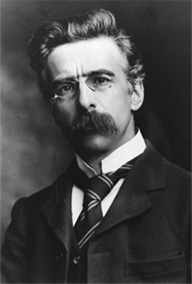Oldhamia antiqua by John Joly, recited by Brigid Christison
Is nothing left? Have all things passed thee by?
The stars are not thy stars! The aged hills
Are changed and bowed beneath repeated ills
Of ice and snow, of river and of sky.
The sea that raiseth now in agony
Is not thy sea. The stormy voice that fills
This gloom with man’s remotest sorrow shrills
The memory of the futurity!
We – promise of the ages! – Lift thine eyes,
And gazing on these tendrils intertwined
For Aeons in the shadows, recognize
In Hope and Joy, in heaven-seeking Mind,
In Faith, in Love, in Reason’s potent spell
The visitants that bid a world farewell!
John Joly -1889

John Joly wrote this poem on the trace fossil Oldhamia, and it captures the beauty of contemplating deep time. In his poem he considers how a fossil may see an entirely different world once uncovered.
Oldhamia is a type of fossil known as an ichnofossil (also called a trace fossil) which preserves evidence of behaviours exhibited by ancient animals, such as walking, feeding, resting etc. Oldhamia is a genus of ichnofossil that date from the Ediacaran Period (635-541 million year ago) to the earlier portions of the Cambrian Period (541-485 million years ago).
When Oldhamia fossils were being produced, sea floors were very different than they are today, with much of the sea floor being covered by extensive “microbial mats” made up of photosynthetic bacteria (those that used sunlight for energy) or chemosynthetic bacteria (those that break down chemicals for energy). Many organisms were adapted to feed on the bacteria in these mats.
Oldhamia ichnofossils record a type of this feeding behaviour, specifically the feeding actions of worm-like organisms that would “mine” for decomposing bacterial matter under the mats. This “mining” involved sifting through sediments and pushing them aside once processed, which produced the “tendril” shapes John Joly describes in in his poem. Oldhamia style fossils do not appear after the Cambrian, probably because of the bacterial mats that they formed on had almost disappeard by the middle of the Cambrian period.

John Joly was a scientist in Dublin for his whole life, joining the Royal Society of Dublin in 1881 and passing away in 1933. His work and interests were extremely diverse, reading like a laundry list of neat scientific topics. These included radiation and radium, colour photography, sap transportation in trees, Martian canals, ice slipperiness, thermometers, yachting, and geology. Apparently he also did annual lighthouse inspections.
In 1899 he announce the oldest estimated age of the Earth yet proposed, 100 million years, based on salt buildup in the oceans. Now we know the Earth is 4.56 billion years old, but this was a time when scientists really started to realise how old the Earth really was.
Poem source:
More on Oldhamia:
More on John Joly: